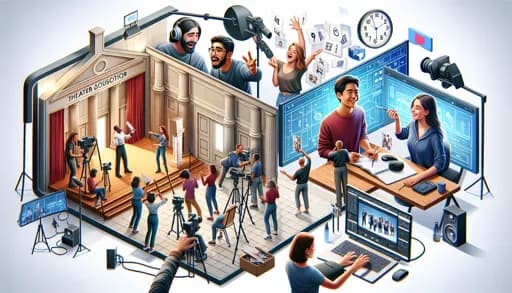Producing and streaming theater performances online require a diverse set of technical skills to ensure smooth and high-quality productions. From setting up equipment to managing streaming platforms, this guide provides a comprehensive overview of the technical aspects necessary for online theater production.
1. Equipment Setup and Maintenance
- Understanding and setting up audiovisual equipment such as cameras, microphones, and lighting fixtures is crucial for capturing the essence of the performance.
- Ensuring proper maintenance of equipment to avoid technical glitches during performances is essential for a seamless experience.
- Familiarity with troubleshooting techniques for common issues like audio/video lag, poor lighting, and connectivity problems is vital for maintaining the quality of the production.
2. Streaming Software and Platforms
- Proficiency in using streaming software such as OBS (Open Broadcaster Software) or Wirecast for capturing and streaming live performances is necessary.
- Knowledge of different streaming platforms like YouTube Live, Twitch, or specialized theater streaming services helps in reaching a broader audience.
- Ability to configure streaming settings for optimal video and audio quality, including resolution, frame rate, and bitrates, ensures high-quality broadcasts.
3. Internet Connectivity and Bandwidth Management
- Understanding internet requirements for streaming high-quality video content, including upload speeds and bandwidth, is crucial for a smooth streaming experience.
- Implementing strategies to optimize internet connectivity, such as using wired connections instead of Wi-Fi and prioritizing network traffic during performances, helps in reducing interruptions.
- Monitoring network bandwidth usage to prevent congestion and ensure smooth streaming without interruptions is important for live productions.
4. Multimedia Integration
- Integrating multimedia elements into online theater productions, such as pre-recorded videos, graphics, and animations, enhances the theatrical experience.
- Syncing multimedia elements with live performances and adjusting timings for seamless transitions contribute to the professionalism of the production.
- Using software tools like video editing software and graphic design programs to create and edit multimedia content allows for creative freedom and innovation in theater productions.
5. Interactive Features and Audience Engagement
- Incorporating interactive features into online theater productions to engage audiences, such as live chats, polls, and Q&A sessions, fosters a sense of community and interaction.
- Moderating audience interactions during performances to maintain a positive and respectful environment ensures that all participants enjoy the experience.
- Implementing audience feedback mechanisms to gather insights and improve future productions is a key strategy for continuous improvement and audience satisfaction.

6. Security and Privacy Measures
- Implementing security measures to protect online theater productions from unauthorized access and piracy is fundamental for protecting the content and the interests of the creators.
- Securing streaming platforms and restricting access to authorized viewers through authentication mechanisms helps in maintaining exclusivity and privacy.
- Ensuring compliance with privacy regulations and safeguarding sensitive information collected during online performances is crucial for legal and ethical reasons.
7. Backup and Redundancy Systems
- Setting up backup systems and redundancy measures to mitigate the risk of technical failures during live performances is a proactive approach to handling potential issues.
- Implementing redundancy for critical components such as internet connections, streaming servers, and power supplies ensures that the show can go on even in the face of technical difficulties.
- Creating contingency plans and protocols for handling emergencies and technical issues during performances is essential for a swift and effective response.
8. Post-Production and Archiving
- Managing post-production tasks such as editing recorded performances, adding subtitles, and optimizing audio/video quality is part of the comprehensive approach to online theater production.
- Archiving and cataloging online theater productions for future reference and distribution helps in preserving the artistic creations for posterity.
- Ensuring compliance with copyright laws and obtaining necessary permissions for archival purposes is important for the legal safeguarding of the material.
9. Environmental Adaptation and Setting
- Adapting various environments and settings to enhance the virtual stage’s visual appeal is crucial for creating an immersive experience.
- Using green screens and digital backdrops to create immersive settings and scenes brings depth and realism to the virtual stage.
- Designing and executing set decorations that complement the theme of the performance without hindering the technical aspects of broadcasting adds a layer of authenticity to the performances.
10. Professional Development and Continuous Learning
- Engaging in continuous learning to keep up with the latest technological advancements in streaming and multimedia integration is essential for staying competitive in the field.
- Attending workshops and training sessions on new software tools and broadcasting techniques enriches the knowledge base and skill sets of theater professionals.
- Participating in professional networks to exchange knowledge and experiences with other theater and streaming professionals fosters a collaborative and innovative community.
By mastering these technical skills, theater professionals can effectively produce and stream captivating performances online, reaching audiences around the world with their creative expressions.